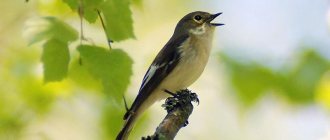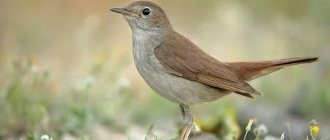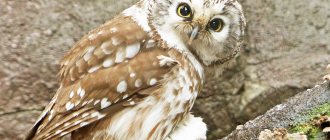The nightingale is a bird known for its amazing, deep and melodious voice, which makes it very recognizable. The vocal abilities of birds have served as inspiration for the development of creativity among many poets, musicians, artists, etc. All this makes the nightingale an interesting object of study both for ornithologists and for ordinary people seeking to understand how such a unique voice can be hidden behind an ordinary appearance . The nightingales themselves belong to the passerine order, which is considered the most numerous among small and medium-sized birds.
Question to the expert
What is the flight speed of nightingales?
Nightingales are among the rather fast birds. Their average speed is about 50 km/h. This cannot be compared with the speed of swifts (115 km/h), but for birds of this size it is considered an excellent indicator.
general characteristics
The sounds of a nightingale forever remain in a person’s memory, once he hears the nightingale’s singing. Such music has a romantic nature, since males without a mate attract the attention of potential girlfriends with melodious singing. At the same time, the nightingales themselves are small birds with an unremarkable appearance, behind which it is not immediately possible to guess such a powerful and beautiful voice.
The nightingale's body dimensions are about 18 cm with a body weight of 25 g. The bird's wingspan is about 27 cm. The plumage color of the most common representatives of this species, common nightingales, is olive-brown. The area of the tail and wings is dark, the belly is light, the sides have a gray tint. The birds have a rather small beak, colored yellow. The nightingale in its appearance resembles an ordinary sparrow, as it has unremarkable external characteristics.
Birds are characterized by the presence of rather powerful limbs and large eyes.
Recommended by topic
Blackbirds Woodpecker Heron
Their plumage can also be reddish-olive with an expressive tint on the chest. When examined closely, even individual feathers can be seen on nightingales.
Some nightingales can be classified as migratory birds, as they go to warmer climes in winter. This applies to those birds that live in cold latitudes. Nightingales living in the southern regions winter in the same areas where their usual habitats are located.
Nightingales are birds that can sing at different times of the day. They can be heard at night, in the morning, if you go out into the forest or grove. Birds live in areas where there is a large amount of vegetation. Their singing tone depends on various circumstances. For example, when they detect danger, birds signal this to their relatives through sounds that resemble croaking.
The nightingales themselves try to minimize contact with people and rarely catch their eye. Therefore, seeing a bird with your own eyes is a rather difficult task, also due to the fact that its color blends with the environment in which it lives. This is due to the gray plumage with a brown tint, which serves as an excellent camouflage for nightingales.
They have gray spots on their chest, similar in appearance to the spots of a song thrush.
Where does the nightingale live?
Nightingales have a wide range of habitats, but a significant concentration of these birds is present in England. Because of this, nightingales are sometimes called English birds. In this place, birds can be found almost anywhere where there is a sufficient amount of vegetation and bushes: in parks, forests, etc. In addition to England, birds live in different countries of the world. For example, in Russia, nightingales can also be seen almost everywhere.
In Iran, nightingales are considered a national symbol, repeatedly sung by local poets.
Nightingales choose to live in areas that are located in lowlands and are characterized by the presence of bushes, hedges and other vegetation. Typically these are areas that are located in river basins or close to other bodies of water. However, birds can also be seen on hills or in bushes that grow quite low, closer to the coastal dunes.
Throughout the day, nightingales constantly change location, which makes it possible for people to listen to their singing in different places. At the same time, night singing, as a rule, sounds from one place. The songs are separated by time periods of 2-3 hours. The first aria is usually performed before midnight, the second is performed closer to the morning.
The most common species, the common nightingale, is a typical migratory bird. Their habitat ranges from the western border of Russia all the way to the Yenisei. In the south, their area of residence runs through the Caucasus and Kazakhstan.
For nightingales, the preferred habitats are lowland mixed forests with high humidity.
They especially like oak forests, which are located in wetlands that run along water bodies. Nightingale nests are located in damp thickets, which are covered with shade from the sun. As a rule, thickets of elderberry or bird cherry are chosen for this.
Sometimes nightingales can be seen in urban areas in areas of public gardens and parks. Birds are attracted to areas with a lot of vegetation, close to lakes and ponds.
With the onset of winter, birds from the northern regions move to Saudi Arabia, northern and eastern Africa for the winter.
Where do swifts and nightingales winter?
Winters
in Africa (while flying the entire continent from north to south) and southern India. There is evidence of wintering birds migrating to the countries of Southeast Asia, in particular to the east coast of Thailand. Nowadays this bird can be found mainly in cities.
Interesting materials:
Is it possible to change the SIM card and leave the MTS number? Is it possible to change mobile operator while keeping the number? Is it possible to view the fine by resolution number? Is it possible to register a car with license plates from another region? Can I call a blocked number? Is it possible to provide only the tax identification number? Is it possible to link a number to two VK pages? Is it possible to check fines by car number? Is it possible to print the Inn by number? Is it possible to put a phone number on a sign?
Features of character and lifestyle
Recommended by topic
Meerkat Dove Deer
Compared to some of their relatives, nightingales have a rather reserved character, as they prefer a solitary lifestyle. It is almost impossible to see a large group of birds that would go for a joint winter with the onset of cold weather. The optimal habitat conditions for nightingales are places with plenty of vegetation and sunlight. There is enough space here for the birds to feel comfortable and independent from others.
Nightingales do not settle near populated areas where people live. However, if a human home is located near the characteristic habitats of birds, you can hear birds singing not far from the house.
A significant part of nightingales are migratory birds. Birds that live in Europe and Siberia go to warm countries for the winter. They have to travel long distances to get to their destination, but even in such harsh conditions the birds rarely gather in groups.
The singing of nightingales depends on many factors and circumstances.
However, regardless of the “status” of the nightingale, the singing of these birds is recognized as one of the most talented and gifted among all birds living on the planet. When birds return to their characteristic habitats in the spring, they begin to sing their songs at their loudest.
Thanks to songs, birds communicate with each other and look for partners. With the help of such an act of communication, they also make it clear to their relatives that this territory is already occupied and is under their protection. If the male does not sing loudly, this means that he already has a lady and does not need to attract the attention of his other half.
Nightingales are quite difficult to see in captivity, as the birds are difficult to catch and tame. They can devote all their time to getting out of their confinement, since they are among the freedom-loving birds for which being kept in a cage is unacceptable. Previously, wealthy people in Russia kept nightingales in their houses until the 19th century. At that time, such exotic birds were considered fashionable pets, which is why the nightingale population suffered greatly.
What are the features of the nightingale's singing?
Male nightingales sing from evening to dawn, often during daylight hours, falling silent for a short time at the height of the day. The nightingale's trill consists of a set of various whistles and clicks. Each of which can be repeated many times. The song of a nightingale can consist of 24 sounds, including whistling, clicking and rumbling sounds.
Interesting materials:
How to make eyebrow gel from soap? How to make eyebrow gel yourself? How to make eyebrow gel lighter? How to make eyebrow fixing gel? How to make helium balloons at home? How to make a gerund? How to create a hyperlink in a presentation? How to make a hyperlink to a sheet in Excel? How to make plaster more plastic? How to make a histogram in Excel 2003?
Reproduction of nightingales
When nightingales fly from warm countries, the first thing they do is search for their soul mate. For birds, the mating season begins in the spring, which ends with the construction of a nest, the creation of a family and the breeding of offspring. Nightingales usually arrive several days before the first vegetation appears. It takes them a couple of days to study the features of the territory, after which the nightingales begin to sing their songs everywhere. This looks especially remarkable at the moment of awakening of nature, which is just emerging from hibernation.
When females pay attention to males and approach them, the males do not simply increase the volume of their singing. They strive to imitate the sounds that females make, fanning themselves with their tails and moving their wings, trying in every way to win the favor of a potential partner.
Females fly to the territory where males have settled closer to evening. During this period, they usually do not show themselves in any way and are in passive anticipation until the morning. With the onset of dawn, females begin to whistle quietly, attracting the attention of males. Often at this moment they begin to jump on the branches of bushes or move along the ground. The males, catching these signals, begin to wriggle, spread their tails, and take different poses.
If both partners like each other, a pair is formed. The female flies up, and the male catches up with her in the air. Thus the mating games of the newly formed family continue.
Nightingales are not monogamous birds. Every time they return from wintering, the birds look for a new partner with whom they will spend the season.
After a few days, when the female feels quite comfortable in the male’s territory, she begins to search for the most suitable place to build a nest. This occurs immediately after mating.
Various grass and fallen leaves are selected for construction.
The nest is lined in a cup-shaped structure that will be on the ground or on vegetation. At the same time, the birds try to place it as close to the surface as possible. Only the female is involved in the construction of the nest, as well as incubation of the eggs. Males constantly sing songs at this time. After the birth of the offspring, the males stop singing, since loud sounds can attract various predators that can attack the nest.
One clutch of a female consists of 4-6 eggs, which have a brownish tint. Each size does not exceed 2 cm in diameter. The clutch is formed in late May or early June. The duration of incubation of eggs is about 15 days. Thus, by the end of June, offspring are born.
The female is responsible for constantly clearing the nest of droppings; her duties include regular maintenance of cleanliness. Both parents search for food together. When the chicks open their bright orange mouths wide, they are showing their hunger. In order to feed them, the male and female have to take turns replacing each other, exclusively searching for food.
The chick with the loudest voice usually gets the most food.
Intensive feeding continues for two weeks, after which the newborn chicks gradually grow to the size of adults and become able to take care of themselves.
The chicks grow throughout the summer. As soon as the beginning of September arrives, parents and children go to warmer regions for the winter to wait out the onset of cold weather.
Elena
Ask a Question
Question to the expert
What is the lifespan of nightingales?
In the wild, nightingales can live no more than 4 years. However, properly organized captive conditions with proper care can significantly extend the lifespan of birds. Often this indicator differs by almost two times.
How does the nightingale family live?
Eggs incubate within two weeks. All this time, the nightingale sings loudly during the day, but this “guard” song is much simpler than his recent call for love. As soon as the chicks are born, the long chants stop so as not to attract attention to the nest with the babies. Both parents are involved in feeding, and, first of all, the food goes to the most vocal chick. At this time, the nightingale produces only short vocal trills, which serve as warning signals. However, they are also the basis for imitation by the younger generation.
After two weeks, the chicks leave the nest, and their parents are freed from worries. The couple breaks up and will most likely never reunite. But next year, after the birds return from wintering, we will again be able to enjoy the magical nightingale nights.
Natural enemies
Despite the fact that nightingales are good at camouflage and hunting, their small size often makes them potentially defenseless against danger in the form of predators. Thus, nightingales are usually hunted by foxes, snakes, cats, weasels, and ermine. Some large birds of prey are also capable of attacking nightingales, such as owls.
In addition, people also often become a source of potential problems for birds. They may admire the nightingale's singing and strive to tame the birds by imprisoning them in a cage. Nightingales do not tolerate captivity conditions well, and therefore often die in such circumstances. In addition, people are engaged in cutting down forests, which constitute the characteristic habitats of birds in the wild.
Despite the hunter's skills, such a small size of the nightingale often puts him in the face of danger. It can easily be caught by cats, rats, foxes, snakes and small predators such as ermine or weasel. Even large birds of prey do not disdain hunting nightingales.











